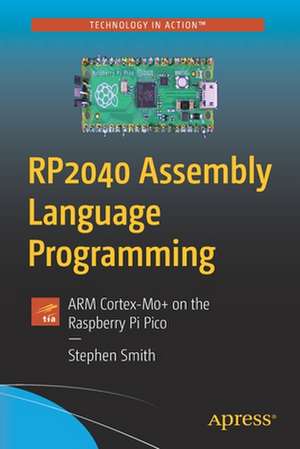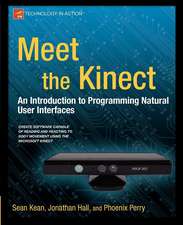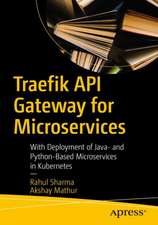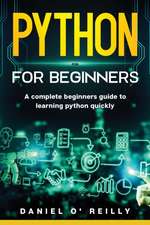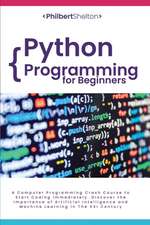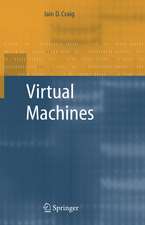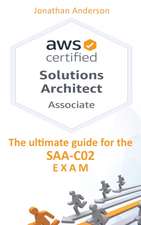RP2040 Assembly Language Programming: ARM Cortex-M0+ on the Raspberry Pi Pico
Autor Stephen Smithen Limba Engleză Paperback – 28 oct 2021
There are eight new Programmable I/O (PIO) coprocessors that have their own specialized Assembly Language supporting a wide variety of interface protocols. You'll explore these protocols and write programs or functions in Assembly Language and interface to all the various bundled hardware interfaces. Then go beyond working on your own board and projects to contribute to the official RP2040 SDK. Finally, you'll take your DIY hardware projects to the next level of performance and functionality withmore advanced programming skills.
What You'll Learn
- Read and understand the Assembly Language code that is part of the Pico’s SDK
- Integrate Assembly Language and C code together into one program
- Interface to available options for DIY electronics and IoT projects
Who This Book Is For
Makers who have already worked with microcontrollers, such as the Arduino or Pico, programming in C or Python. Those interested in going deeper and learning how these devices work at a lower level, by learning Assembly Language.
Preț: 260.69 lei
Preț vechi: 325.87 lei
-20% Nou
Puncte Express: 391
Preț estimativ în valută:
49.88€ • 52.08$ • 41.28£
49.88€ • 52.08$ • 41.28£
Carte disponibilă
Livrare economică 15-29 martie
Preluare comenzi: 021 569.72.76
Specificații
ISBN-13: 9781484277522
ISBN-10: 148427752X
Pagini: 280
Ilustrații: XXIII, 320 p. 19 illus.
Dimensiuni: 155 x 235 x 22 mm
Greutate: 0.49 kg
Ediția:1st ed.
Editura: Apress
Colecția Apress
Locul publicării:Berkeley, CA, United States
ISBN-10: 148427752X
Pagini: 280
Ilustrații: XXIII, 320 p. 19 illus.
Dimensiuni: 155 x 235 x 22 mm
Greutate: 0.49 kg
Ediția:1st ed.
Editura: Apress
Colecția Apress
Locul publicării:Berkeley, CA, United States
Cuprins
Chapter 1: How to Set Up the Development Environment.- Chapter 2: Our First Assembly Language Program.- Chapter 3: How to Build and Debug.- Chapter 4: How to Load and Add.- Chapter 5: How to Control Program Flow.- Chapter 6: Thanks for the Memories.- Chapter 7: How to Call Functions and Use the Stack.- Chapter 8: Interacting with C and the SDK.- Chapter 9: How to Program the Built-in Hardware.- Chapter 10: How to Initialize and Interact with Programmable I/O.- Chapter 11: How to Set Up and Catch Interrupts.- Chapter 12: Multiplication, Division, and Floating Point.- Chapter 13: Multiprocessing.- Chapter 14: How to Connect Pico to IoT. Appendix A: ASCII Character Set.- Appendix B: Assembler Directives.- Appendix C: Binary Formats.- Appendix D: The ARM Instruction Set.
Notă biografică
Stephen Smith is a retired Software Architect, located in Gibsons, BC, Canada. He's been developing software since high-school, or way too many years to record. Since retiring he has pursued Artificial Intelligence programming, earned his Advanced HAM Radio License and enjoys mountain biking, hiking, and nature photography. He continues to write his popular technology blog at smist08.wordpress.com.
Textul de pe ultima copertă
Learn to program the Raspberry Pi Pico’s dual ARM Cortex M0+ CPUs in Assembly Language. The Pico contains a customer System on a Chip (SoC) called the RP2040, making it the Foundation’s first entry into the low-cost microcontroller market. The RP2040 contains a wealth of coprocessors for performing arithmetic as well as performing specialized I/O functionality. This book will show you how these CPUs work from a low level, easy-to-learn perspective.
There are eight new Programmable I/O (PIO) coprocessors that have their own specialized Assembly Language supporting a wide variety of interface protocols. You'll explore these protocols and write programs or functions in Assembly Language and interface to all the various bundled hardware interfaces. Then go beyond working on your own board and projects to contribute to the official RP2040 SDK. Finally, you'll take your DIY hardware projects to the next level of performance and functionalitywith more advanced programming skills.
You will:
- Read and understand the Assembly Language code that is part of the Pico’s SDK
- Integrate Assembly Language and C code together into one program
- Interface to available options for DIY electronics and IoT projects
Caracteristici
Program the Raspberry Pi Pico in ARM 32-Bit Thumb Assembly Language Control the custom PIO processors with PIO Assembly Language Understand low-level mechanics of the Raspberry Pi Pico systems
